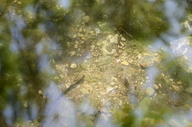|
Eurycea naufragia Chippindale, Price, Wiens & Hillis, 2000
Georgetown Salamander, San Gabriel Springs Salamander Subgenus: Paedomolge | family: Plethodontidae subfamily: Hemidactyliinae genus: Eurycea |
 © 2013 Diogo B. Provete (1 of 4) |
|
|
Country distribution from AmphibiaWeb's database: United States
U.S. state distribution from AmphibiaWeb's database: Texas
Eurycea naufragia Chippindale, Price, Wiens and Hillis, 2000 Paul T. Chippindale1 1. Historical versus Current Distribution. Georgetown salamanders (Eurycea naufragia) were described by Chippindale, Price, Wiens, and Hillis (2000) from springs of the San Gabriel River drainage in the vicinity of Georgetown, Williamson County, Texas; they also provisionally included one spring and one cave population from further north in Williamson County in this species. A cave population that probably represents this species was recently discovered west of Georgetown (J. Reddell, personal communication). Most of the known populations were discovered recently; the few populations known prior to the work of Chippindale (1995) and Chippindale et al. (2000) had been considered peripheral isolates of Texas salamanders (E. neotenes; Sweet, 1978a, 1982). Georgetown salamanders are members of the "northern group" of Chippindale (1995, 2000) and Chippindale et al. (2000); this monophyletic group occurs northeast of the Colorado River in the Edwards Plateau region of central Texas. Based on molecular markers, this and other northern species are extremely divergent from E. neotenes and other Eurycea from the southern Edwards Plateau region (Chippindale et al., 2000). 2. Historical versus Current Abundance. Little is known of the historical abundance of Georgetown salamanders. Several of the spring populations occur adjacent to Lake Georgetown, and it is likely that others were submerged when this manmade lake was created. Springs in Georgetown's San Gabriel Park, a historical locality for this species (Sweet, 1978a, 1982) have been heavily modified. One juvenile specimen was discovered at this site in 1991 (Chippindale et al., 2000), but existence of this species at these springs appears precarious. Chippindale et al. (2000) briefly addressed some aspects of the conservation biology of this species; see Price et al. (1995) for a more detailed discussion. 3. Life History Features. A. Breeding. Reproduction is aquatic. i. Breeding migrations. Unlikely to occur. ii. Breeding habitat. Same as adult habitat. B. Eggs. i. Egg deposition sites. Unknown; some other spring-dwelling species of central Texas Eurycea are thought to deposit eggs in gravel substrates. ii. Clutch size. Unknown. C. Larvae/Metamorphosis. Georgetown salamanders are paedomorphic, and natural metamorphosis is unknown. D. Juvenile Habitat. Probably similar to adult habitat. E. Adult Habitat. Completely aquatic. Georgetown salamanders are known only from the immediate vicinity of spring outflows, under rocks and leaves and in gravel substrate, and from two water-containing caves. Water temperatures in springs of the Edwards Plateau are relatively constant throughout the year and typically range from 18–20 ˚C or slightly warmer near the fault zone at the Plateau's edge (Sweet, 1982). Sweet (1982) provided a comprehensive distributional analysis of the central Texas Eurycea and discussed hydrogeology of the region in relation to salamander distribution. F. Home Range Size. Unknown. G. Territories. Unknown. H. Aestivation/Avoiding Dessication. Unknown. I. Seasonal Migrations. Unlikely to occur, although there may be seasonal variation in surface versus subsurface habitat use. J. Torpor (Hibernation). Probably active throughout the year. K. Interspecific Associations/Exclusions. Unknown. L. Age/Size at Reproductive Maturity. Unknown. Average SVL of specimens measured by Chippindale et al. (2000) was 29.0 mm; all measured were thought to be sexually mature, but this was only verified for some of the specimens. M. Longevity. Unknown. N. Feeding Behavior. Prey probably consists mainly of small aquatic invertebrates, but no detailed feeding studies of this species have been conducted. O. Predators. Unknown. P. Anti-Predator Mechanisms. Secretive. Q. Diseases. Unknown. 4. Conservation. Georgetown salamanders were described only recently (Chippindale et al., 2000) and most known populations were discovered within the past decade. Little is known of their historical abundance, although several populations occurred adjacent to Lake Georgetown, and it is likely that they were submerged when this manmade lake was created. Springs in Georgetown's San Gabriel Park have been heavily modified, and the existence of Georgetown salamanders at these springs appears precarious. They currently are considered as a Candidate species for Federal listing (http://ecos.fws.gov), but they have not been protected by the State of Texas (www.tpwd.state.tx.us). 1Paul T. Chippindale Literature references for Amphibian Declines: The Conservation Status of United States Species, edited by Michael Lannoo, are here. Feedback or comments about this page.
Citation: AmphibiaWeb. 2025. <https://amphibiaweb.org> University of California, Berkeley, CA, USA. Accessed 15 May 2025. AmphibiaWeb's policy on data use. |



 Raffaëlli Account
Raffaëlli Account Map of Life
Map of Life